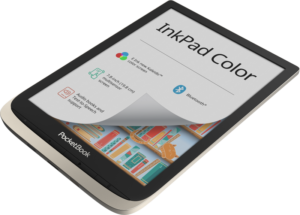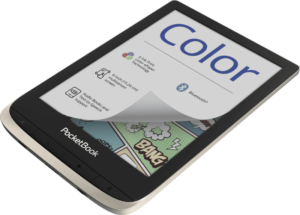PocketBook introducing an ebook reader with a 7.8”colour e-ink display
 Articles
Articles
German Language / Deutsche Sprache
PocketBook InkPad Color: Großer eReader in Farbe – COMPUTER BILD
Inkpad Color: Neuer E-Reader mit Farbdisplay – PC-WELT
From the horse’s mouth
PocketBook
InkPad Color reader (Product Page)
Video – Click or tap to play in YouTube
My Comments
Previously, PocketBook who is a Switzerland-based eBook reader manufacturer, offered the first colour eBook reader which has a very useable colour e-ink display. This unit was with a 6” display.
But they have extended this to an eBook reader with a larger 7.8” display but achieving the same “dot-per-inch” resolution as the 6” model. The frontlight is even designed to work properly with E-Ink Kaleido and yield the best visual performance even if it is turned down to the lowest level.
Most of the features for this PocketBook InkPad Color are the same for both the PocketBook Color eBook readers with things like text-to-speech, Bluetooth connectivity, and support for audio files based on MP3, Ogg Vorbis and AAC codecs. But it also has Wi-Fi which would come in to its own for downloading eBooks and other “electronic hard copy” material from PocketBook’s own electronic bookstore, Dropbox and ReadRate. It also has a built-in RSS-based Webfeed reader for those of us who follow blogs and other online services using this standard technology.
The large colour display may come in to its own with graphic novels or other illustrated material. I would see this more so in France and Belgium where the “BD” visual novels and comic albums are an artform unto themselves. Even business and education would value the large colour screen for illustrated materials delivered in electronic hard copy.
The PocketBook InkPad Color will weigh in at 225g even though it has the large screen. It will cost EUR€299 in Europe or US$330 in the USA.
It will be interesting to know how the E-Ink Kaleido technology will be taken further. In the near term, it could be about moving towards larger colour e-ink displays. But it could also lead towards work on photo-quality colour e-ink displays, making for electronic photo frames that use this technology or even towards colour digital signage.
What needs to happen is for more eBook readers to license and implement colour e-ink technology. Here, a colour display can be seen by an e-book reader manufacturer as a product differentiator just as size or network / Internet connectivity is used for that purpose. It can encourage authors and publishers to use colour as a drawcard for their eBook versions of their works.

